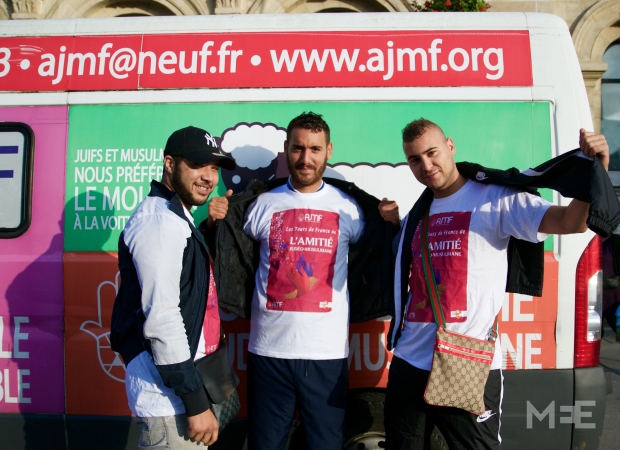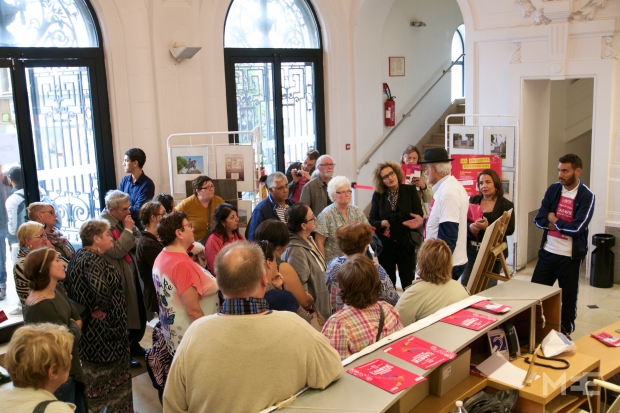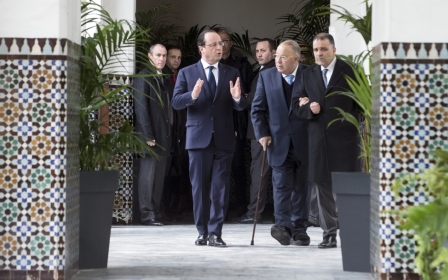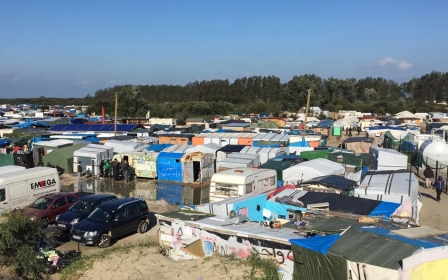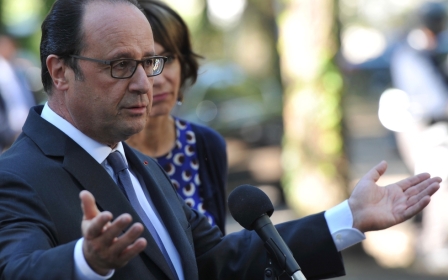A rabbi, three young Muslims and a minibus: A tour de France for dialogue
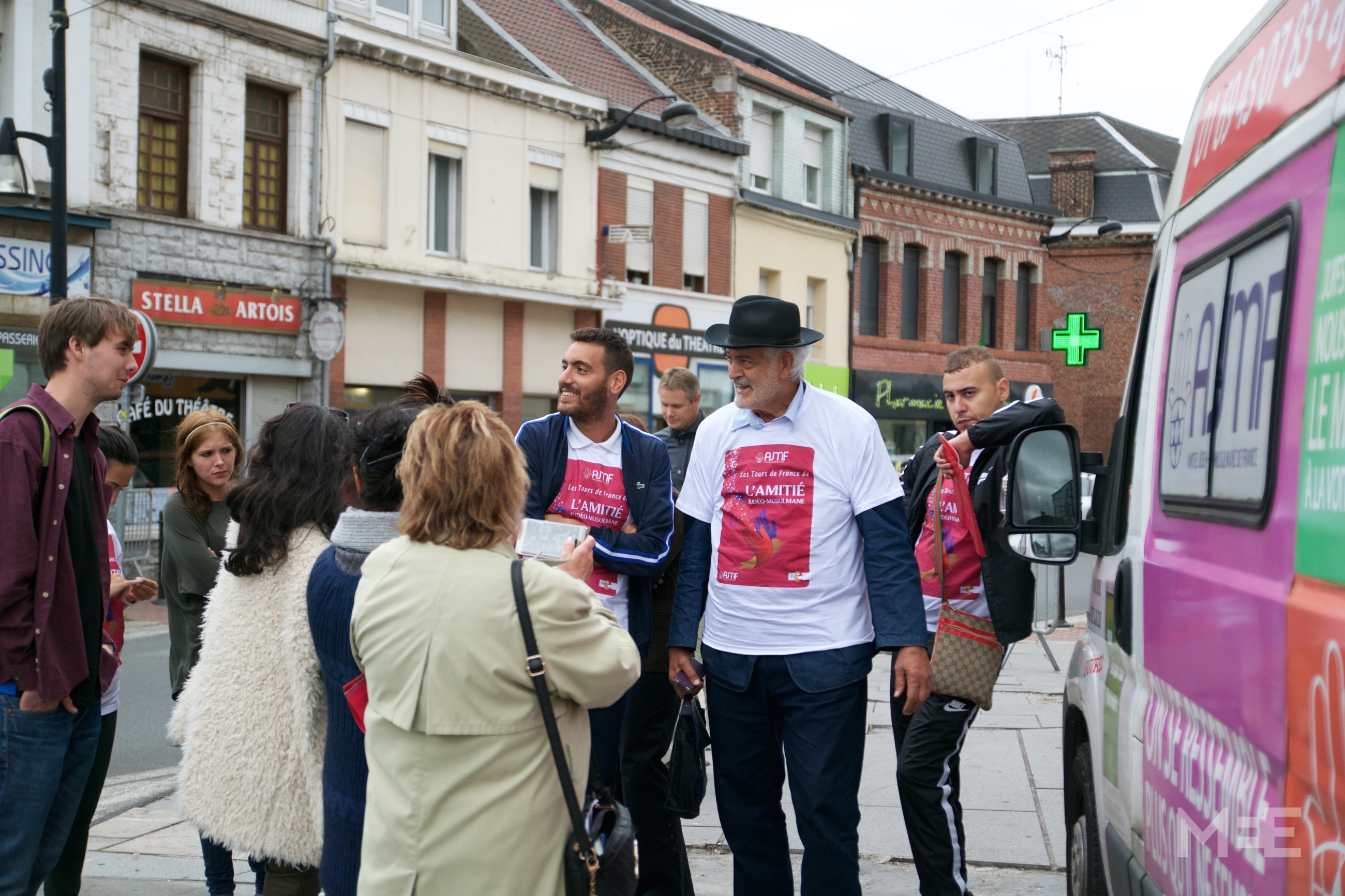
DENAIN, France – On the sidewalk in front of the local theatre, a crowd gathers around Rabbi Michel Serfaty and his colourful bus.
Anti-discrimination slogans like "We are more alike than you think" and "Solidarity between Jews and Muslims," and "I dreamt of God and she was black," cover the vehicle.
“People have tried to rip off the stickers, but they are still here, and so are we,” Rabbi Sefarty quips to the curious audience.
Rabbi Serfaty is the leader of the Jewish-Muslim Friendship Association (AJMF). Since 2004, he has crisscrossed France 10 times to promote peace and dialogue between Muslims and Jews.
“Our goal is to create friendship between Muslims and Jews to replace this animosity that has developed in France,” explained the 73-year-old.
While it is against French law to collect statistics about religion, there are an estimated 500,000 Jews and 4.7 million Muslims living in the country; the largest communities of both religions in Europe.
Despite their seeming prejudices against one another, Sefarty believes both communities actually know very little about each other.
Middle East-France connection
From the Israeli-Palestinian conflict to the war in Syria, decades of strife in the Middle East have had negative repercussions on Muslim-Jewish relations in France.
“It is incomprehensible that there is so much tension between the two religions when they have so much in common,” said the religious leader.
According to DILCRA, the government’s anti-racism agency, more than two anti-Semitic attacks are reported every day making for a total of 806 incidents in 2015. Meanwhile, violence against Muslims has tripled: 425 aggressions were reported in 2015 compared to 133 in 2014.
Moroccan-born Rabbi Serfaty was himself assaulted by a group of young men in 2004 - he assumes because of his outwardly Jewish appearance. Since the January 2015 terrorist attacks on satirical magazine Charlie Hebdo and the Hyper Kosher supermarket, he has to move around accompanied by a police detail at all times.
However, Serfaty says that it is the rise of the Islamic State group with their subsequent attacks on French soil and recruitment of the country’s young Muslims that has further antagonised both communities. While the number of French people making the journey dropped in 2016, 689 French citizens remain in northern Syria and Iraq, including 275 women and 17 underage fighters.
“France is facing a huge challenge with returning jihadists. How do we rehabilitate them and reintegrate them into our society? We need to stop the youth from leaving in the first place, which we can do by working in their neighbourhoods, the banlieues,” explained the Rabbi.
Taking the message to the streets
Throughout France, the banlieues – or suburbs – have become synonymous with violence, drug dealing and religious extremism. According to Insee, France’s national statistics agency, they are also the poorest neighbourhoods in the country, home to mostly migrants and their children.
“The banlieues are France’s thermometers: when the country is on edge, they are the first to explode,” said Serfaty.
With the support of the French government, AJMF hired three young Muslim men as community outreach workers. The youth are from Tarterets in Corbeil-Essonnes, a social housing project often used as an example of the social issues facing banlieue residents.
“As soon as something happens in the Middle East, particularly between Israel and Palestine, there are violent demonstrations in Tarterets,” said Serfaty.
Growing up in Tarterets, Karim Boussak heard negative stereotypes about Jews. He says his family was initially concerned about his new job.
“At first, my family and friends told me to be careful,” explained the 22-year-old. “Today, they are proud of me and the work I do.”
Oussama Messaoudi’s father encouraged his son to join AJMF. Originally from Algeria, the elder Messaoudi regretted the mass exodus of his Jewish friends to Israel and France in the 1960s.
“My father cried when the Jews left Algeria. He taught me to respect everyone,” said the 24-year-old.
A history buff who considers himself a devout Muslim, Hassane Bounabie decided to work with AJMF to teach others about the similarities between the two faiths.
“Since the Middle Ages, Muslims and Jews have lived side-by-side in peace, so I don’t think this should change now,” he said.
'Since the Middle Ages, Muslims and Jews have lived side-by-side in peace, so I don’t think this should change now'
Breaking down stereotypes
According to psychologist Melanie Pejaras, stereotypes have a negative impact on personal development, especially among young people.
“When adolescents learn stereotypes, it impacts their way of thinking and their behaviour with people who are different from them,” Pejaras explains. “To grow into tolerant adults, young people need to understand what stereotypes are and how they work in our society.”
When asked what his family and friends think about his job, Bounabie said he has experienced positive and negative reactions.
“People are taken aback when they see [Rabbi Serfaty and I] together, but I am often told that I am giving a good image of Muslims,” explained the 25-year-old.
Stereotypes are also deeply rooted among French Jews. When the friendship bus stops in predominantly Jewish neighbourhoods, people are hesitant to speak to the group.
“Misunderstandings about Muslims – their cultures and their beliefs – have only fostered fear, distrust and suspicion about their community,” said Serfaty.
Serfaty and his team once met a group of Hassidic Jews in Paris who informed the rabbi that he did not understand the Torah’s teachings.
“Issac and Ishmael were enemies, so Jews and Muslims will hate each other forever,” they told him.
His aim is to add young Jewish recruits to his community outreach team. However, only one Jew has ever applied for a position, compared to the dozens of keen Muslim candidates.
Building a peaceful future
Back in Denain, a crowd has gathered inside the local theatre. Organising events, such as public talks, sporting tournaments and cooking classes is one of the ways the NGO hopes to get Muslims and Jews to engage in constructive dialogue.
For Mehdi Ghalem, a social worker, attending the event was an opportunity to meet a Jewish religious leader and learn more about Judaism.
“I don’t know many Jews, since there aren’t many in Denain,” he explained. “As a Muslim, I am very proud of these three young men who are positive role models.”
The group’s message touched Djalifa Brahimi, a Muslim from Denain, who witnessed interreligious tensions within her own family. Her brother married a Jewish woman, but relatives from both sides discouraged the union.
“While [my brother and his wife] now have a beautiful son, not everyone accepted their decision at first,” she explained. “So, I cried when I saw Rabbi Serfaty and these young Muslim men together on TV.”
Working together to protect peace in France
AJMF staffer Bounabie remains optimistic about the possibility of building positive relationships between Muslims and Jews.
“I hope that one day we will see more Muslims and Jews walking together in the streets,” he said. “We need to work together to protect peace in France, which I am afraid we may lose because of the current wave of attacks.”
When asked about his plans for retirement, Rabbi Serfaty said he is struggling to find a replacement, as the next generation of rabbis and imams seem more hesitant to work together.
“Intolerance has dug its claws into our society,” he explained. “I will continue this work as long as possible because I am afraid of what will happen if we give up.”
This project gives hope that the next generation of religious leaders will also work together to build bridges between Jews and Muslims in France.
This article is available in French on Middle East Eye French edition.
Middle East Eye propose une couverture et une analyse indépendantes et incomparables du Moyen-Orient, de l’Afrique du Nord et d’autres régions du monde. Pour en savoir plus sur la reprise de ce contenu et les frais qui s’appliquent, veuillez remplir ce formulaire [en anglais]. Pour en savoir plus sur MEE, cliquez ici [en anglais].




